How Cheetos In Mexico Are Different From The American Kinds

Mexico and America may be different in many ways, but when it comes to crunchy snacks, people on either side of the border have pretty similar tastes. Take Cheetos. Charles Elmer Doolin invented the snack in 1948, and today they are sold in over 35 countries under the PepsiCo umbrella. Now, Cheetos are a staple in convenience stores and supermarkets in both countries with legions of fans loving the corn-based snacks dusted with intense, cheesy flavoring. But are these neon-colored, finger-staining snacks the same north and south of the border? The short answer is no.
To uncover the truth about Cheetos in Mexico versus the United States, we did a deep dive into how the products differ in each country. We looked at everything from packaging to ingredients, nutritional information, and flavors on offer. We also sampled comparable products from the U.S. and Mexico to see whether or not we could detect differences in taste, texture, and color. Here's what we found.
Read more: US Foods You Surprisingly Can't Find In Canada
You Won't Find Chester Cheetah On Mexican Products
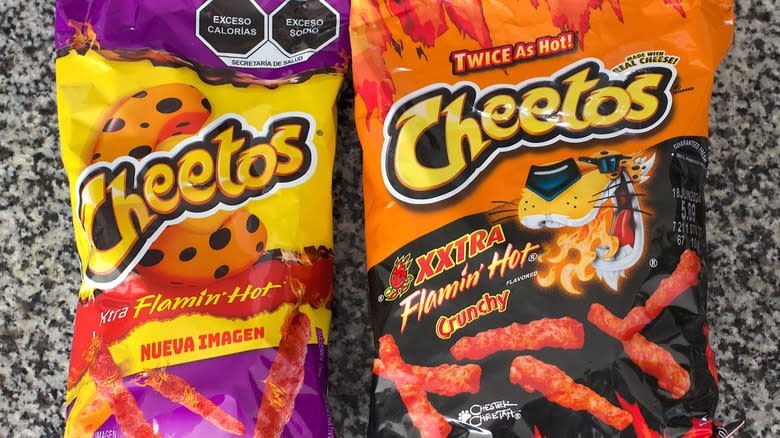
If you grab a bag of Cheetos in Mexico, you might notice that there is one key element missing from the bag: Chester Cheetah, the brand's iconic cartoon mascot. Of course, it's not like Chester was always there, even in America. The original Cheetos mascot was a mouse who was rather uncreatively named Cheet-os Mouse. That mascot got the boot in the late '70s, leaving room for Chester Cheetah to come on the scene in 1986. Chester has been the face of the brand in America ever since.
The reason Chester Cheetah doesn't make an appearance on Mexican Cheetos is due to a 2018 law that bans cartoon characters on food products as part of an effort to battle obesity in children. The rationale is that animated characters may influence children to choose unhealthy products over more nutritious foods. Other characters ousted from packaging in Mexico include Tony the Tiger and Osito Bimbo on Bimbo pastries. Cheetos in Mexico now sport an orange C with cheetah spots instead of the sunglass-wearing, too-cool-for-school cartoon cheetah.
Mexican Cheetos Have Food Warning Labels
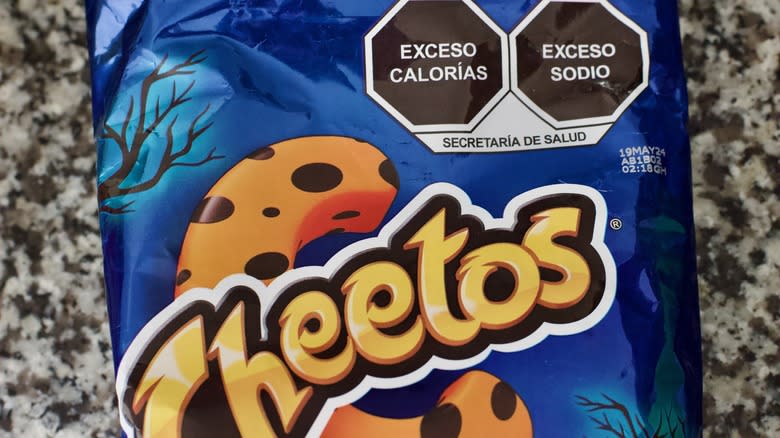
Another thing you might notice about the packaging of Mexican Cheetos is that every bag has food warning labels clearly displayed on the front of the bag. These black octagons alert you to the fact that the Cheetos are high in calories and salt. Once again, this is due to a Mexican law that aims to prevent food-related health issues like obesity, diabetes, and hypertension.
Mexico's food warning label law went into effect in 2020 and states that all food products must display warning labels if they are high in calories, salt, sugar, trans fat, or saturated fat. The labels must be displayed on the front of the package and have to be printed in addition to nutritional panels and ingredient lists. While there has been a lot of talk about how food labels don't always work in the U.S., they have affected change in Mexico with more people declining to buy products that are labeled as unhealthy.
There Are Different Flavors And Styles In Either Nation
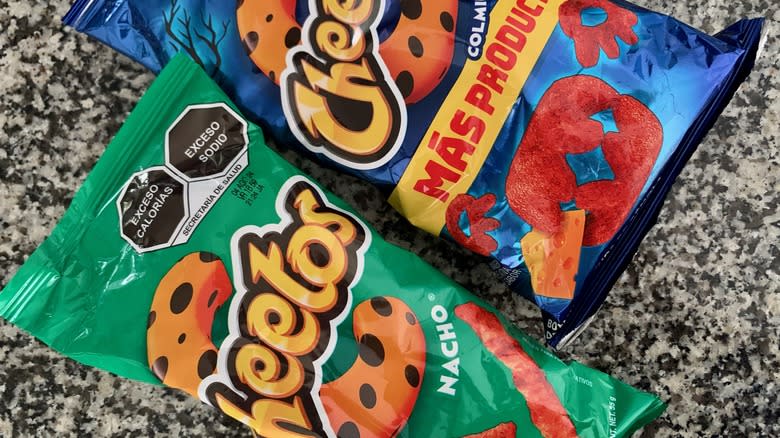
Americans may be familiar with popular Cheetos flavors like the OG Crunchy Cheetos, Flamin' Hot Puffs, and Crunchy Cheddar Jalepeño Cheetos. What you may not know is that there are tons of Cheetos flavors you can only find internationally. So, it follows that, in Mexico, there are several flavors and styles of Cheetos that you won't see on the shelves in the States. Likewise, some U.S. products haven't made their way into mainstream stores in Mexico.
Cheetos Colmillos is one style that is specific to Mexico. "Colmillos" is Spanish for fangs, which is exactly what these puffy chili and cheese-flavored snacks look like. According to our Mexican source, these are a favorite with kids who like to wear the fangs before scarfing them down. According to the Cheetos website, the ball-shaped variety known as bolitas were only available in Mexico until recently.
On the flip side, it's pretty hard to find white cheddar or Buffalo-flavored Cheetos in Mexico. Even seemingly classic Mexican flavors like Mexican Street Corn and Cheddar Jalepeño are thin on the ground. And you can pretty much forget about snagging Cheetos pretzels or Cheetos Mac n' Cheese while you're down south.
Some Of The Names Vary
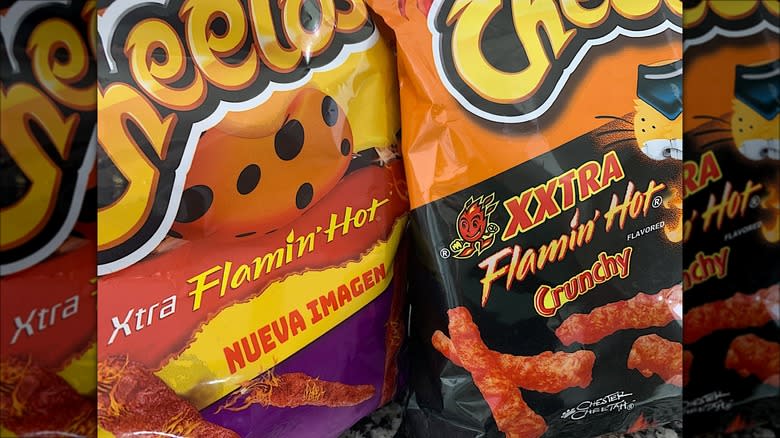
Die-hard Cheetos fans will be happy to know that some flavors are available in both Mexico and the United States. For example, you can find the classic Crunchy Cheetos and Flamin' Hot Cheetos flavors in both countries. However, the names can be slightly different. Most of the time, this comes down to the difference between Spanish and English. Puffs are known as Poffs in Mexico, while Cheetos are colloquially called chetos in Mexico. Our Mexican source explained that this is because there are no words with a double e in Spanish, so it's pronounced as an "eh" instead.
In some cases, the product name has a completely different meaning despite having the same flavor and style. Take the original Crunchy Cheetos, which are called Cheetos Torciditos in Mexico (torciditos means twists in Spanish). There are also slight differences between the names of the extra fiery version of Flamin' Hot Cheetos. In Mexico, the snacks are called Xtra Flamin' Hot, while in the States they're called Xxtra Flamin' Hot. Does that mean they're hotter in the States? That's debatable.
The Colors Are Slightly Different
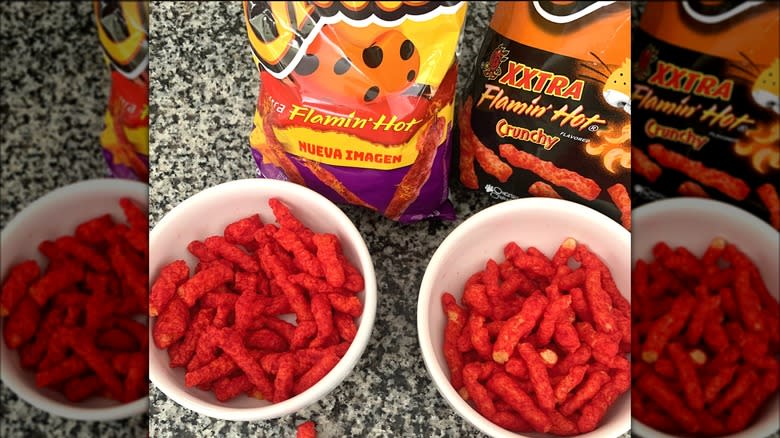
Depending on the type of Cheetos you're consuming, the colors can be more intense in one country than the other. We taste-tested the Xtra Flamin' Hot Cheetos from Mexico against their American counterparts and found that the Mexican Cheetos were a deeper red. This could have been due to more seasoning on the crunchy corn puffs or simply that the American chips were jostled more in the bag, causing some of the seasoning to come off. Either way, we didn't find them vastly different in color.
Other taste testers have found greater differences in the colors of other types of Cheetos. TikTokker @mand163_ posted a video comparing the standard Crunchy Cheetos and Cheetos Torciditos, saying, "When you look at the coloring and the spices, you can see right away that the Mexican version are more heavily spiced and they look more natural versus the American version that has that really artificial neon orange kind of coloring."
The Texture Of Mexican And American Cheetos Can Be Distinct

Whether you're a fan of Crunchy Cheetos or the softer Puffs, part of what makes Cheetos so hard to put down is the texture of the snack. All Cheetos begin as a mixture of cornmeal and water. The batter is put through a machine that transforms it into the shapes that we know and love. Next, Crunchy Cheetos are fried, while the Puffs are baked. You would expect the same process to be used worldwide, resulting in Cheetos with consistent texture across the globe. However, our investigation found that to be far from the truth.
Based on our taste test of the Xtra Flamin' Hot Crunchy Cheetos, we found that our sample of Mexican Cheetos was noticeably fluffier than the American version. The snacks had more visible air pockets, while the American Cheetos were more dense and crunchy. The Mexican variety was also slightly bigger than the American ones, which may have contributed to the fluffy quality.
The Flavors Are Noticeably Different
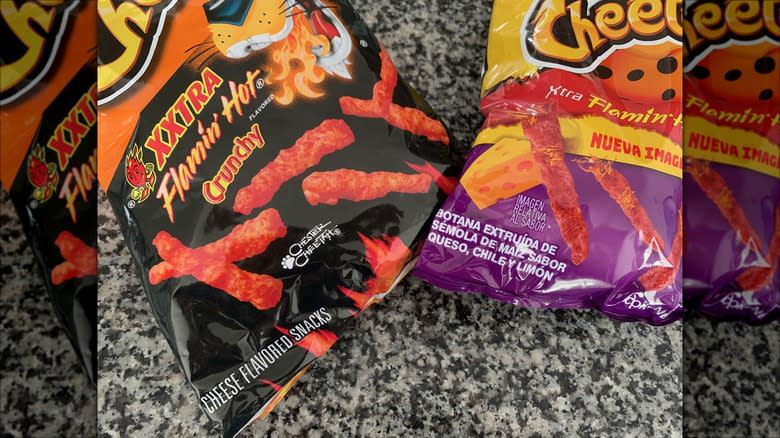
Now to the part you've probably been waiting for — the flavor. We found that the Mexican version of the Xtra Hot Flamin' Cheetos had more depth of flavor than the American version, with an earthy more complex taste that hinted at a greater variety of spices. The American Cheetos tasted more vinegary and were a bit spicier. The hosts of Good Mythical Morning had a similar experience, stating that the Mexican Flamin' Hots tasted smokier and cheesier than the American version, while the American Cheetos had a more distinctly fiery kick.
Yet looking at the ingredient lists doesn't reveal any glaring differences. The Mexican list is rather vague, listing especias (spices) without saying exactly which ones go into the mix. It also lists a mezcla de quesos (mix of cheeses) without specifying which variety. On the other hand, the American ingredient list states there is cheddar cheese and buttermilk in the mix, which may be why the American Cheetos taste slightly tangier than the Mexican version. The front of the American bag states the contents are "cheese-flavored snacks," while the Mexican version claims there are flavors of cheese, chili, and lime inside.
There Are Nutritional Differences
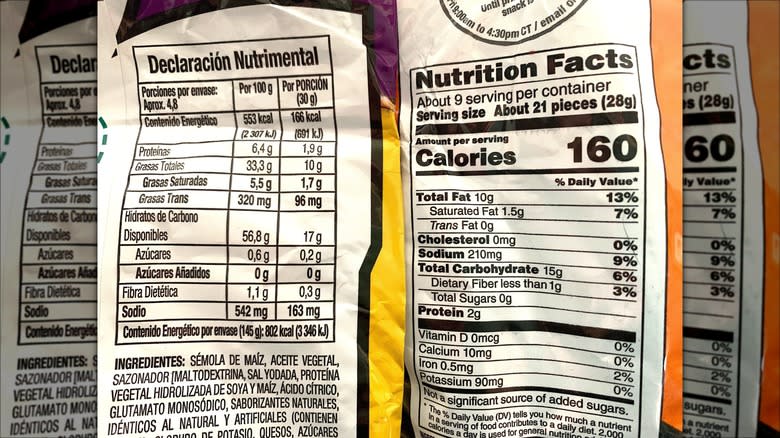
We all know — or should know — that Cheetos aren't good for you. As an example, you may have already experienced what happens when you eat too many Flamin' Hot Cheetos. At best your tongue feels like it's on fire and your stomach may feel a little sketchy. At the absolute worst it could land you in the emergency room with gastrointestinal problems (though that's a very remote possibly for most of us). And, yes, both your common sense and a quick look at the labels on the bags show that the snacks are pretty low in nutritional value. But how do the Mexican and American versions stack up against one another?
Both Mexican and American versions of the Xtra Flamin' Hot Cheetos contain roughly the same calories. The Mexican Cheetos are 166 calories per 30-gram portion, while the American Cheetos are 160 calories per 28-gram portion. However, the trans fats, sodium, and sugar contents are slightly different. The Mexican Cheetos contain 0.96 milligrams of trans fat and 0.2 grams of sugar, while the American Cheetos contain zero trans fat and zero sugar. That may seem like a huge win for team U.S.A., but if we're really going to be scoring things, American Cheetos lose a point for having 210 milligrams of sodium versus 163 milligrams of sodium for the Mexican version.
Mexican Cheetos Are Manufactured And Marketed By A Dedicated Company
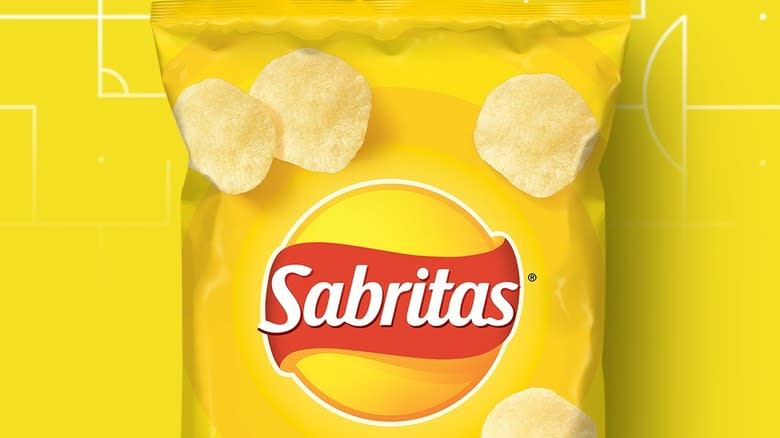
Though it had its origin in the late 1940s, the snack known as Cheetos gained greater exposure in the U.S. when Charles Elmer Doolin and Herman W. Lay merged their businesses into Frito-Lay in 1961. When that company joined with Pepsi-Cola in 1965, the snacks exploded on the international scene. PepsiCo still owns the Cheetos brand today and has subsidiaries that produce and distribute the snacks in other regions. In Mexico, that subsidiary is Sabritas.
Sabritas has a lengthy history that pre-dates Cheetos. Pedro Antonio Marcos Noriega founded the company in Mexico City in 1943, and it quickly gained popularity for its tasty fried snacks. Sabritas was acquired by PepsiCo in the 1960s and is now one of the biggest snack companies in Mexico. The company manufactures and distributes a few different Frito-Lay snacks, including Cheetos, Doritos, and Fritos. Sabritas also has its own line of snacks that include Sabritas potato chips, Rancheritos crispy corn snacks, and Pake Taxo, which are mixed bags of crunchy, cheesy, chili-flavored goodness.
Read the original article on Mashed

